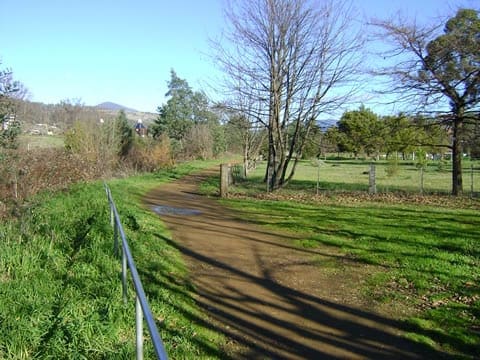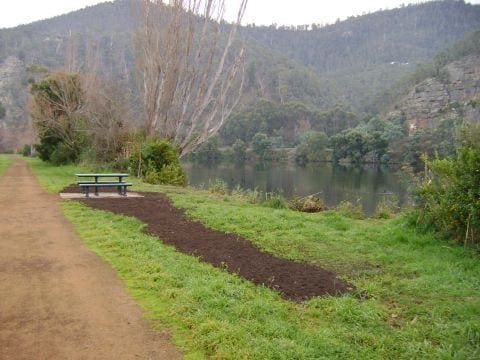Hike at a Glance
Max elevation: 15m
Min elevation: 13m
Total Ascent: 5m
Hike overview
Discover Fisherman's Walk, a delightful 300m, grade 2 stroll nestled in the picturesque Derwent Valley of Tasmania. This short walk promises a leisurely 15-minute amble through serene bushland to a beloved fishing spot.
As you follow the gently sloping track, you'll be immersed in the tranquility of nature, with lush foliage and the sounds of the nearby river soothing your senses. The walk culminates at a popular fishing location, offering anglers a serene retreat to cast their lines and enjoy the beauty of the surroundings.
Gallery
Got some great shots from this hike? Upload your photos here to inspire others and show off the beauty of the trail!
Click to view form >>
Submitting your photos doesn’t mean you lose ownership. You can be credited for your contributions, and you can request removal at any time.
Content use
Please don’t copy GPX files or content from this site to AllTrails or other platforms. Each trail has been personally mapped, documented, and refined to support Australia’s bushwalking and hiking community. While some details come from land managers, every listing reflects significant personal effort. This is a free, community-driven initiative—your respect helps keep it that way.
Walk map and GPX file
Max elevation: 15 m
Min elevation: 13 m
Total climbing: 5 m
Total descent: -4 m
For more information on this trail, visit Greater Hobart Trails
Getting there
Getting to the trailhead: Derwent Valley.
Access to Fisherman’s Walk is convenient, with parking available off Glenora Road.
Closest towns to this walk: Bothwell, Bridgewater, Bushy Park, Hamilton, Maydena, New Norfolk, Ouse, Plenty, Westerway
About the region
Just a short drive from Hobart, the Derwent Valley stretches from Granton to Mount Field, Lake St. Clair to Lake Pedder. The beautiful Derwent Valley is Tasmania's must-stay experience. The locals know that the Derwent Valley is Tasmania's best kept secret. Perfectly, sublimely beautiful. Pristine. Vast, with warm pockets of civilisation. Since it earliest history, the Derwent Valley has always been a favourite destination for Tasmanians, first for the indigenous peoples and later for the European settlers, and so on until the present day.
Similar walks nearby
Looking for more walks in or near Derwent Valley? Try these trails with a similar difficulty grade.
Track grade
Grade 2 (Easy) - A Gentle Introduction to Inclines: Grade 2 on the AWTGS represents easy walking tracks that offer a slightly more challenging experience compared to Grade 1. Similar to Grade 1, no prior bushwalking experience is required. The track surface is typically hardened or compacted and may have gentle hill sections or occasional steps. The total distance of a Grade 2 walk is typically no greater than 10 kilometers. These walks are still suitable for families with a bit more experience or those seeking a gentle introduction to some inclines.
Explore safe
Plan ahead and hike safely! Carry enough water, pack layers for changing conditions, and bring safety gear like a torch, PLB, and reliable communication device. Check official sources for trail updates, closures, and access requirements, and review local weather and bushfire advice. Most importantly, share your plans with someone before you go. Being prepared makes for a safer and more enjoyable hike! Stay Safe, Explore More, and Always #ExploreSafe.
Packing checklists
What you carry in your pack depends on factors like weather, terrain, and your adventure type. Not sure what to bring? My free planning, food, and packing checklists are a great starting point, covering day hikes, overnight trips, and multi-day adventures. Use them to customise your kit and always prioritise safety.
Let someone know
Before heading out, take a moment to fill out your trip intentions form. It’s a quick way to share your hike details with family or friends. If something goes wrong, they can notify emergency services, ensuring a faster response and peace of mind. Stay safe and enjoy your adventure
Suggest an edit
Spotted a change on this trail? Maybe there are new features, the route has shifted, or the trail is permanently closed. Whatever the update, I’d love your input. Your feedback helps fellow hikers stay informed and ensures that our trail info stays fresh and reliable.
Acknowledgement of Country
Trail Hiking Australia acknowledges the Traditional Owners of the lands on which we hike and pay respects to their Elders, past and present, and we acknowledge the First Nations people of other communities who may be here today.






